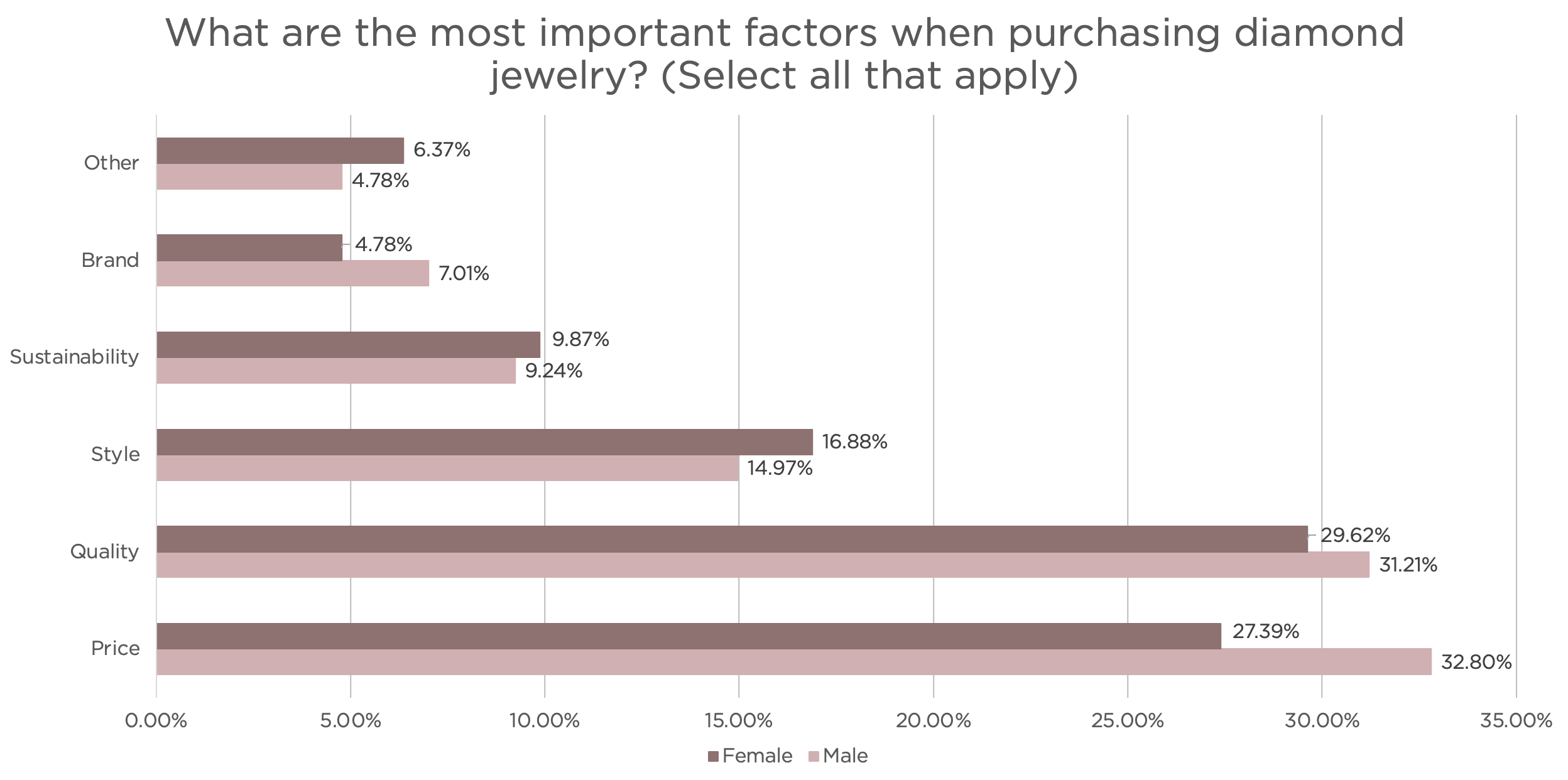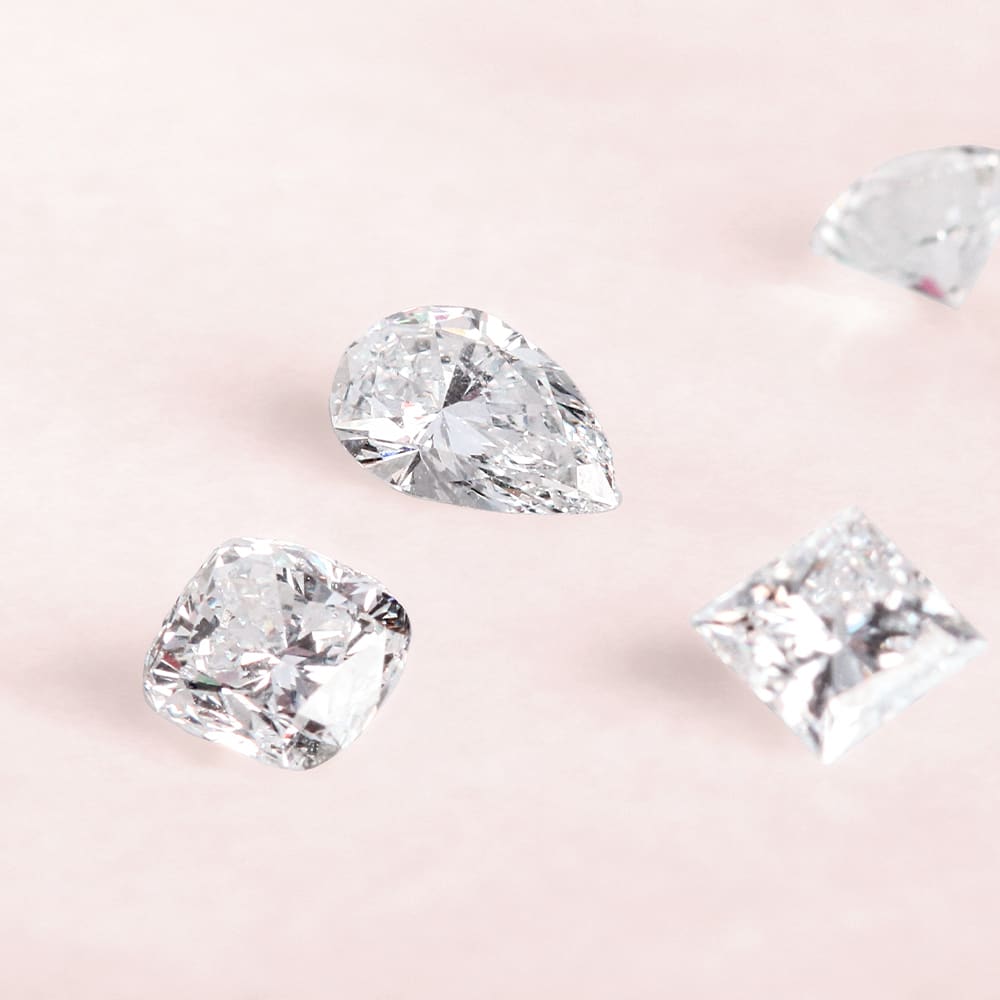53% of Consumers Don’t Know the Difference Between Mined Diamonds vs. Lab Diamonds

So, what is the difference between a lab grown diamond and a mined diamond?
Well, it’s not something you could tell with the naked eye. In a recent survey, we discovered that 53% of consumers don’t know the difference between mined diamonds vs. lab diamonds. Although more than half of all survey respondents didn’t know the difference, there are a few important differences.
In this guide, we explore the misconceptions, differences, and benefits of each diamond choice. We think that in the end, you’ll find they aren’t different at all when it comes to look and durability, but they are vastly different where it counts in terms of price, ethics and environmental impact. We’ll also explore how 12FIFTEEN offers an array of lab-grown diamond choices should you choose to purchase. Read on for the ultimate guide to lab-grown vs earth mined diamonds, and learn how you can ensure your perfect stone is also a smart purchase.
What Are Lab-Grown Diamonds?
Despite the expanding availability of lab-grown diamonds, many consumers only have a foggy idea about how the lab-grown diamond industry works. What are lab created diamonds? Let’s tackle the big questions that come up when learning about this type of diamond:
- Are lab created diamonds real? – There’s no fakery when it comes to lab-grown diamonds. These stones are 100% real—physically, chemically, and molecularly. When the question, “Are laboratory grown diamonds real?” is brought up, the answer is an unequivocal, “yes.” These diamonds are as real as any natural diamond dug out of a mine.
- What does “lab-created diamond” mean? – It’s taken decades of research and technical innovation to recreate the earth’s processes in a lab. Lab created diamonds are created through two methods: CVD and HPHT. Overall, lab-created means a stone was manufactured with pure carbon, a diamond seed or fragment, and high-pressure equipment used to reproduce the circumstances that cause natural diamonds to form in nature.1
How Are Diamonds Mined?
For most people, the process of getting a rough diamond from inside the earth to set inside of a ring is vague at best. That’s because for nearly 100 years, the De Beers company maintained a monopoly on earth mined diamonds and diamond mines.2
De Beers no longer holds a monopoly on diamonds, but the production and mining practices they invented are still utilized.
If you’re wondering, “How are diamonds mined?” the process can take several forms, including:
- Open-pit mining – Much as it sounds, earth and rock are blasted away with explosives and powerful drilling equipment to reveal diamonds relatively close to the surface. Picture massive, circular craters, filled with miners and diggers extracting the raw stones.
- Underground mining – Through a network of tunnels, miners and excavators can reach diamonds deep below the earth’s surface. These tunnels may go several meters into the earth and require considerable planning and construction.
- Ocean mining – Yes, there are also diamonds in the oceans. Huge freighters equipped with water mining mechanisms search the seafloor for these precious jewels.
Of course, this is only the first step for mined diamonds. There is an extended process of transporting, processing, sorting, cutting, polishing, often all occurring at different facilities across the world.
Who Needs To Know About Diamonds?
Who’s buying diamonds? Mined or lab-grown, diamonds are most frequently on the minds of those thinking about marriage or couples who have just tied the knot.
Studies have shown that different age groups have a different level of understanding when it comes to diamond manufacturing. Studies suggest that:
- Older couples are most familiar – Perhaps those with some marriage experience behind them have a greater awareness of diamonds. 55% of 35 to 44 reported understanding the difference between lab-grown and mined diamonds, as did 46% of 45-64 yr olds and 53% of those 65 and older.
- Younger couples are slightly less informed – Only 37.9% of those 18 to 24 reported understanding the difference between a lab created diamond and an earth mined diamond. While younger individuals do commonly get married, it is also not uncommon for them to have other important life milestones to be tackling. Some can be securing degrees, building their careers, and learning about themselves before embarking on the path to finding their perfect match and the right ring to complement their true love. However, the average age for marriage today is 30 years old for men and 28 years old for women. Perhaps it’s not surprising then that 46% of those aged 25-34 reported understanding the difference between lab and mined diamonds, which was also the average percentage understanding across all age groups.

What Are The Cost Differences?
Whether lab-grown or mined, diamonds are a significant investment. After all, these stones are made to last, upwards of a billion years.4 While factors like quality, style, sustainability and brand are necessary factors to making the right diamond purchase, price is the most important factor when diamond shopping for 33% of men according to our survey.
The cost of a diamond will depend on the size, cut, and clarity of the stone, but if you’re in the market, you can expect to spend up to 50% less on lab-grown compared to the same quality mined diamond. That could translate to savings of hundreds or even thousands of dollars.
Why are laboratory-grown diamonds significantly less expensive? Consider these key differences:
- Supply and demand – While the demand for diamonds has remained relatively steady, the supply of lab-grown diamonds has helped to end price-hikes related to scarcity. Lab-grown diamonds are evening out the playing field and adding more options for consumers to save.
- Less awareness – As our research has shown, many consumers are simply unaware of lab-grown diamonds. Now is an unprecedented time to invest in this expanding industry. The price of lab diamonds may likely increase as more consumers are informed about this burgeoning industry.
- Shorter supply chain – Mined diamonds move from the extraction site to processing facilities, to distributors and vendors, often making several stops in between. The cost of transporting these materials is passed off on the consumer, leading to higher prices. Lab-grown diamonds have a much shorter supply chain from the lab to your finger. What this means is that lab-grown diamonds are created, cut and polished by a separate company and sold by the distributor.
Ultimately, lab-grown diamonds are a fiscally sound choice when shopping for engagement rings, weddings rings, bracelets, and so much more. Look to companies offering a wide range of synthetic diamonds to ensure you find the perfect stone for your specific needs.
What Type of Diamonds Are More Valuable?
There are four key criteria for determining a stone’s value. You might know them as the 4C’s of Diamonds:
- Cut Grade
- Color
- Clarity
- Carat
These quality considerations are the same across the board for lab-grown and mined diamonds. No matter what manufacturing process, our survey has shown that 30% of women report that quality is the most important factor when purchasing a diamond.


What Is the Environmental Impact of Diamond Mining?
Perhaps the most significant difference between lab-grown and mined diamonds is the impact that these processes have on our planet. The same shimmer can mean two very different things for our important and fragile ecosystem.
Our recent survey revealed that 69% of individuals have little to no knowledge about the impact the diamond mining industry has on our environment.
Mining is a dangerous and destructive practice and may affect the earth in any of the following ways:
- Soil erosion – As the surface of the earth is removed to gain access to underground diamonds, once-fertile soil is eroded and swept away. This process leads to less arable land for agricultural development.
- Deforestation – Trees and forests are a natural hindrance to resource extraction. Large swaths of land are bulldozed to make room for diamond mines.
- Ocean dredging – Ocean mining vessels use vacuum hoses to extract the sediment to the ocean floor, potentially interfering with deep ocean organisms and causing irreparable damage to various ecosystems.
- Habitat displacement – As lands and waters are exposed to diamond mining, plants and animal habitats may be destroyed or displaced, leading to unpredictable effects on the greater wildlife populations.
Additionally, these facts don’t take into account the human cost of diamond mining. Whether through neglect, unsafe business actions, and exploitation, many individuals are directly harmed by the mining process.
How You Can Support Safe and Sustainable Diamonds
Can you tell the difference between a lab-created diamond and a mined diamond? No. With that said, you can make a difference by choosing to support a transparent and ethical lab-grown diamond business, and contribute to a more sustainable future. When taking our survey, 66% of respondents reported that they didn’t own any sustainably-sourced jewelry, and 63% said they did not understand what “sustainably sourced” meant. Let’s be clear. Lab-grown diamonds are sustainable for the following reasons:
- They avoid destructive environmental practices.
- They are crafted without the unfair, unethical, and dangerous labor practices of mining.
- They use minimal fossil fuels and lead to less carbon emission.
For many, sustainable practices are a cornerstone of smart shopping, personal ethics, and contributing to a future we can all be proud of.
12FIFTEEN Diamonds: Make Your Diamond Matter

Footnotes:
- Smithsonian Magazine. Diamonds on Demand.
https://www.smithsonianmag.com/science-nature/diamonds-on-demand-48545144/ - Business Insider. The Incredible Story Of How De Beers Created And Lost The Most Powerful Monopoly Ever.
https://www.businessinsider.com/history-of-de-beers-2011-12 - Census.gov. Median age at first marriage: 1890 to present.
https://www.census.gov/content/dam/Census/library/visualizations/time-series/demo/families-and-households/ms-2.pdf - New York Times. Are Diamonds Really Forever?.
https://www.nytimes.com/2017/06/12/science/diamonds.html
Sources:
Smithsonian Magazine. Diamonds on Demand.
https://www.smithsonianmag.com/science-nature/diamonds-on-demand-48545144/
Business Insider. The Incredible Story Of How De Beers Created And Lost The Most Powerful Monopoly Ever.
https://www.businessinsider.com/history-of-de-beers-2011-12
Business Insider. The Complete Story Of How Diamonds Are Mined.
https://www.businessinsider.com/how-diamonds-are-mined-2012-8#the-manner-in-which-diamonds-are-cut-and-polished-also-depends-on-their-color-24
Census.gov. Median age at first marriage: 1890 to present.
https://www.census.gov/content/dam/Census/library/visualizations/time-series/demo/families-and-households/ms-2.pdf
New York Times. Are Diamonds Really Forever?.
https://www.nytimes.com/2017/06/12/science/diamonds.html

